164 Search Results for visual schedule
April 21, 2015
by Carole Zangari -
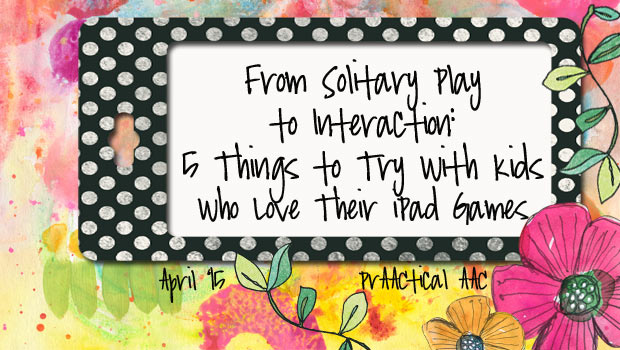
“But my kid wants to use the app on his own terms, not with ME!” Ever faced this conundrum? There are so many wonderful apps that are terrific for building interaction and language skills, but some of our prAACtical friends don’t want us to interact with them during iPad play**. Today, we’re thinking about strategies to use when kids would rather engage in solitary play as opposed to welcoming us as interaction partners in their iPad games. How can we help them increase their tolerance for interaction when playing on the iPad? Here are a few things to try. Make expectations clear with visual supports. It’s hard to cooperate when you don’t have an understanding of what’s supposed to happen. When kids are used to playing games, reading books, or watching videos on their own, they sometimes resist our participation out of the fear that they won’t get to do... [Read More...]
January 29, 2015
by Carole Zangari -
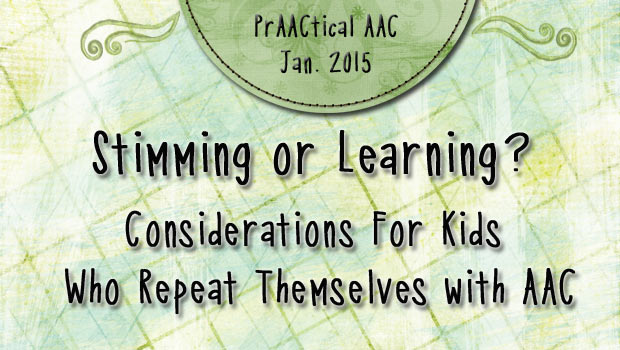
At the CARD 2015 conference earlier this month, I had some great conversations with professionals who wanted to integrate more AAC into their work with beginning communicators. One of the issues that came up was this: What about kids who keep using their AAC to say the same thing over and over? Here are some of the things we discussed. For beginning communicators, repetition is part of exploration. And exploration is part of language learning. Extinguish repetition and we have effectively shut down a tool for language development. Turning off the device, taking it away, or turning the volume controls to silent is NOT an option. (Whew! I can’t tell you how happy I was to hear consensus on that point!) No feeling person would tape the mouth of a speaking child to keep them quiet, and this is the AAC counterpart. Silencing a person by restricting access to their... [Read More...]
September 23, 2014
by Carole Zangari -
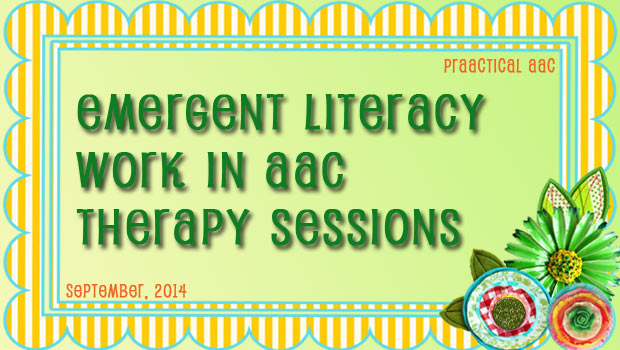
We strive to use some of our therapy time to build the literacy skills with all of our beginning communicators. It’s not easy. First, because they often have little to no interest in it (at first), but mostly because our time together is quite limited. Here are some of the things we’ve been doing. Having our clients sign in themselves (Think: name stamps, stickers, tracing, or even making a mark) Looking for their name on their therapy room door: We make signs and print two copies. We give them one in the waiting room so that they can match it to the sample on the door. Formatting the visual schedule so that the client does some writing (Think: check box, crossing off the activity when finished) Picking a book or the topic: For some of clients we use the books themselves, but for most we use their AAC. It’s time... [Read More...]
May 15, 2014
by Robin Parker -

About Teaching Core Words Teaching Core Vocabulary Core Vocabulary All Day Long 5 Things To Do If You’re Not Confident Teaching Core Vocabulary Joining Core and Fringe Vocabulary What’s The Connection: Visual Schedules and Core Vocabulary Core Words and the Curriculum Core Words, Direct Vocabulary Instruction, & The Beginning Communicator Core Vocabulary: Making Sense of Symbols More on Teaching Core Vocabulary Thoughts on Teaching Core Vocabulary Teaching Core Vocabulary with Direct Instruction Strategies Core Vocabulary- Specific Teaching Ideas PrAACtical AAC Core Words & July Fourth: Get Ready, Get Set, Go Cookies and Core August Core Word PrAACtice Ideas September PrAACtice With A Year of Core Words October PrAACtice With A Year of Core Words November Core Word PrAACtice Ideas December Core Word PrAACtice Ideas Core Word Vocabulary Words A Year of Core Vocabulary Another Year of Core Vocabulary The First 12: Getting Started With Core Words More on Core Words:... [Read More...]
May 5, 2014
by Carole Zangari -

Let’s start with a basic premise: We can’t maximize AAC learning outcomes unless we’re working well with families. This is easier said than done, especially in some settings. As a clinician in a university clinic, for example, seeing families is the norm. We get to interact with them before and after the therapy. They get to observe or participate in the session. We can show them the data, observe how they interact with the AAC user in their family, and answer questions as they arise. And even with all of that, supporting them is challenging in that it takes time, skill, and planning. Although it is one of our favorite things to do, it’s not always easy to align our actions with our (stellar, ambitious) intentions. Multiply that by a factor of a zillion for our colleagues in schools and other settings where frequent, casual interactions are difficult to come... [Read More...]
April 18, 2014
by Carole Zangari -
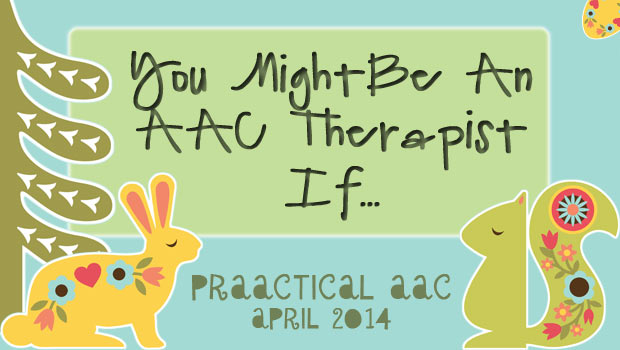
You peruse the dollar store muttering “What could I do with this?” You squeal in delight when Amazon puts personal laminators on deep discount. You find yourself wanting to point to symbols when you talk to friends and family. You buy velcro if you see a good deal, even if you don’t need it. You’ve seriously considered making a voodoo doll in the image of the insurance person who issued the most recent denial of coverage. You have an Allen wrench at the bottom of your purse. You have an un-natural fondness for clip art and Creative Commons. You’d rather sit in a great conference presentation than go to see the latest movie. You can think of a dozen ways to make page fluffers. You’re so ‘over’ goals for making eye contact. You’ve made friends with the guy who cuts Lexan at the home supply shop. You think of the... [Read More...]
February 6, 2014
by Robin Parker -

Strategy of the Month: PrAACtice Opportunities Building a PrAACtice Routine PrAACtical Communication Opportunities in SLP Sessions Using Aided Language To Build Communication Opportunities PrAACtical Excercise: Building Fluency with Decontextualized PrAACtice PrAACtical Thinking Ringing in the New Year with an AAC App Giveaway- acorn Another Year of Core Vocabulary Get Organized for the New Year- 5 Visual Schedule Apps A PrAACtical Week: 2014 #1 Watch it Wednesday- Pain in Children with Developmental Disabilities PrAActical Peek: Decorating Cookies 31 Posts You May Have Missed in December A PrAACtical Week 2014 #2 Does AAC Really Work with Infants & Toddlers Watch it Wednesdays- Using and Creating Routines to Promote Interactions Throwback Thursday: Visual Schedule Roundup A PrAACtical Note of Appreciation A PrAACtical Week 2014 #3 Watch It Wednesday: I Hear Them All A Totally Different Life A PrAACtical Week #4 SpeakAll! A Research-to-Practice Project Make It PrAACtical: Make Your Own Battery Interrupter (Without Soldering) ... [Read More...]
January 18, 2014
by Robin Parker -
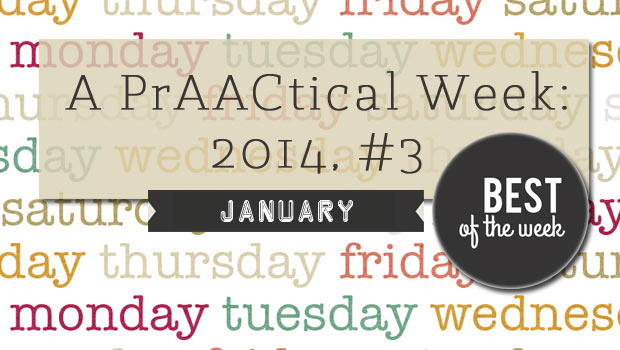
It’s been an awesome PrAACtical Week. Take a look: Sunday: PrAACtical Communication and a Business Monday: PrAACtical Communication Opportunities in SLP Sessions Tuesday: Does AAC Really Work with Infants and Toddlers? Wednesday: Watch It Wednesday – Creating and Using Routines to Promote Interaction Thursday: Throwback Thursday – Visual Schedule Round-Up Friday: A PrAACtical Note of Appreciation (Don’t miss the downloads!)
January 4, 2014
by Carole Zangari -
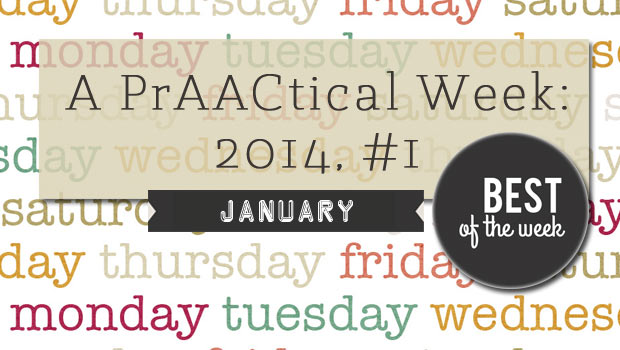
Well, it’s a prAACtical New Year and we are ushering in a few new tweaks in 2014. Among them, a weekly wrap-up. Here’s a look at our prAACtical week. Sunday: 10 Tips for Using a Natural Aided Language Board by Gail Van Tatenhove Monday: Tracking Early Communication Skills – A PrAACtical Resource (free download) Tuesday: It’s PrAACtically a New Year Wednesday: Ringing in the New Year with an AAC App Giveaway Thursday: A(nother) Year of Core Vocabulary Friday: Get Organized! Visual Schedule Apps If you’re looking for our Strategy of the Month post, stay tuned – those will be published on Mondays.
September 21, 2013
by Carole Zangari -

Like some of you, we are often met with skepticism when we encourage teams to work on literacy skills with individuals who are still learning the very basics of communication. Recently, we had the opportunity to begin this journey anew, and model a literacy lesson for kindergartners who have no formal communication system, are not answering yes/no questions, and do not consistently select preferred items when offered choices. Why work on literacy with students who are not routinely expressing their basic preferences? Because the longer we wait, the longer it will take to get there. Because it offers wonderful opportunities to build communication, too. Because when other people see us teaching reading and writing, it changes their perception of the student in a positive way. Because they will enjoy it. Because there are mandates for us to address the general education curriculum. Because if we set the bar high and... [Read More...]









